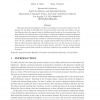Free Online Productivity Tools
i2Speak
i2Symbol
i2OCR
iTex2Img
iWeb2Print
iWeb2Shot
i2Type
iPdf2Split
iPdf2Merge
i2Bopomofo
i2Arabic
i2Style
i2Image
i2PDF
iLatex2Rtf
Sci2ools
AR
2005
2005
Insights toward robot-assisted evacuation
This paper discusses the application of robotic technologies to an evacuation assistance task. We describe how this kind of task differs from the more prevalent search and rescue efforts, and how this difference affects the approach taken in building systems focused on the evacuation phase. The paper describes the implementation and evaluation of a deployment algorithm intended to distribute audio navigational cues throughout an office building environment. A review of evacuation dynamics methods is presented and particular methods are used within the deployment algorithm in an on-line sense. We use a pedestrian simulation and a simple model of audio-evacuee interaction in order to show the effects of beacon deployment; this indicates that even a very few beacons can result in a large decrease in the mean and variance of egress distance (and time). We also advance possible uses for human motion based methods of environment evaluation more broadly for mobile robotics in general.
| Added | 15 Dec 2010 |
| Updated | 15 Dec 2010 |
| Type | Journal |
| Year | 2005 |
| Where | AR |
| Authors | Dylan A. Shell, Maja J. Mataric |
Comments (0)

